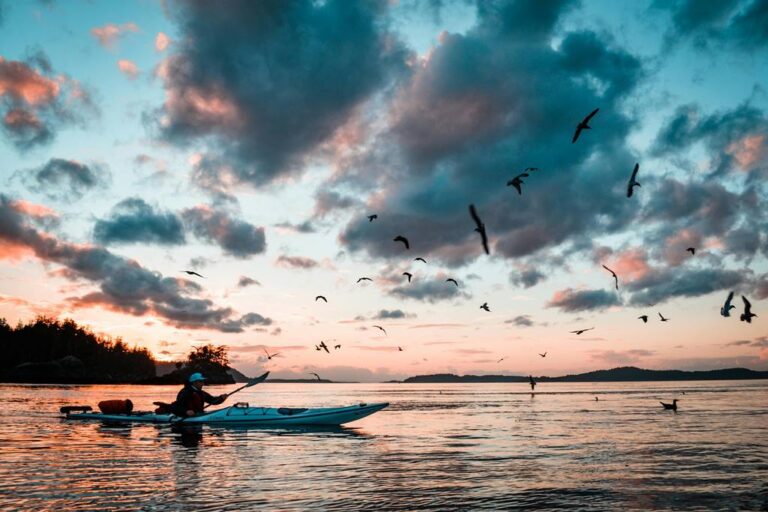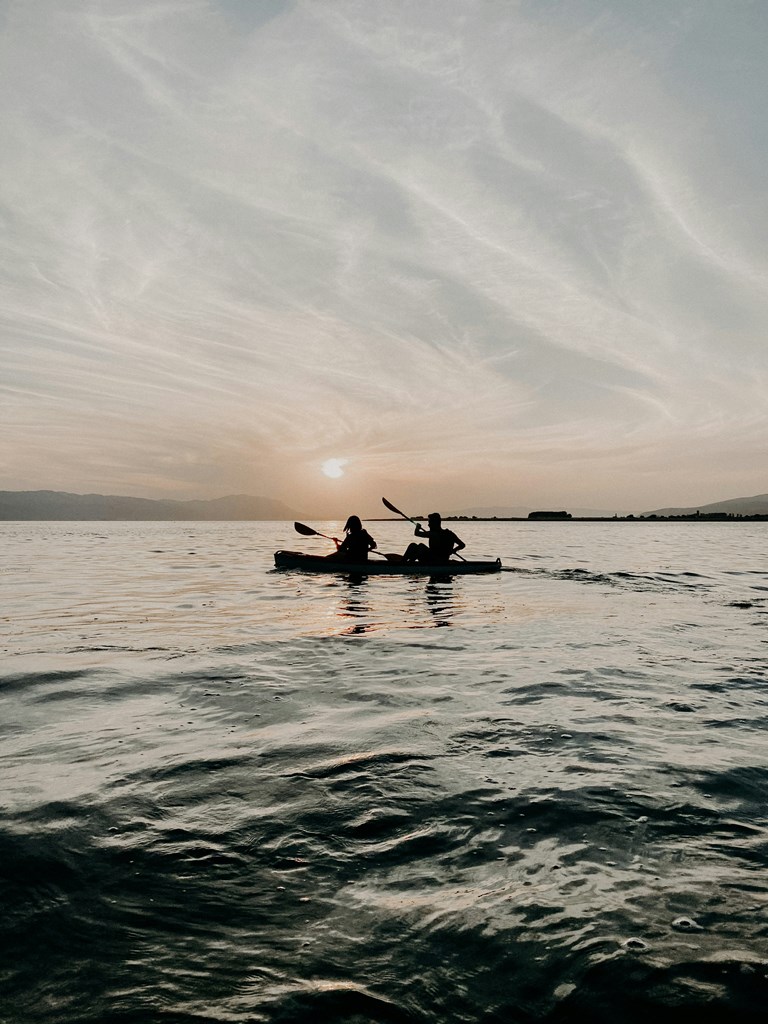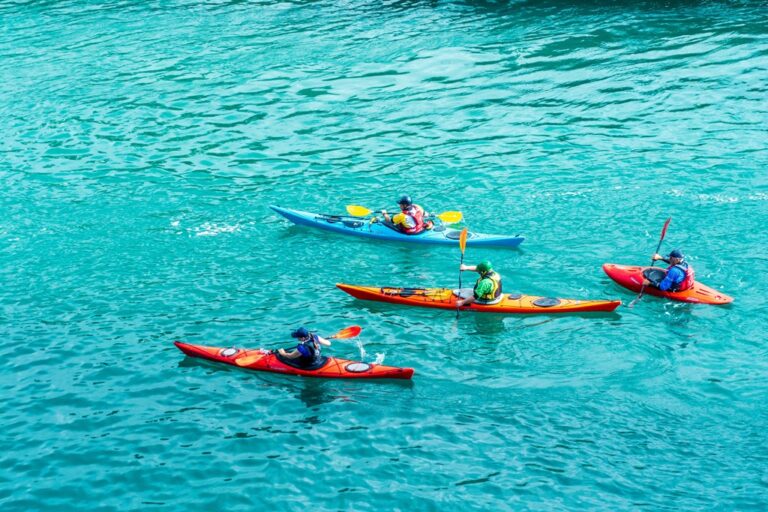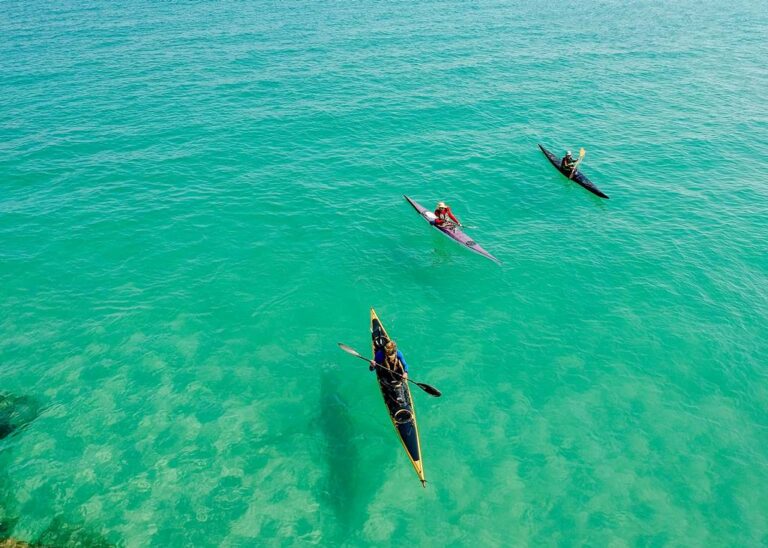
Kayaking is a fantastic way to deepen your connection with nature, blending adventure and tranquillity perfectly. In today’s hectic world, where we often feel disconnected and overwhelmed, nature provides essential healing and peace. Kayaking lets you explore scenic waterways, glide through serene lakes, and navigate winding rivers. As you paddle, you’ll witness breathtaking landscapes and wildlife up close, filling your heart with joy and gratitude. It’s not just a sport; it’s a heartwarming experience that brings you closer to nature’s wonders.
By choosing to kayak, you’re engaging in a fun and exciting activity while investing in your mental and emotional well-being. The calming effect of water, combined with the rhythmic motion of paddling, helps reduce stress and promotes mindfulness. So, what is kayaking? It’s a priceless gift that keeps on giving, enriching your bond with nature. Embrace the adventure and let nature’s beauty rejuvenate your spirit. Amid heart-warming rivers, you visit the rainbow of life, painting your mind with calmness and peace, understanding the adventure and beauty of life. Want to know more about kayaking? Please read our blog to learn about the best season, types, and equipment.
Table of Contents
What is Kayaking? Explained
It’s a fun and thrilling water sport that involves using a kayak—a narrow boat propelled with a double-blade paddle. As you navigate through waterways, you sit facing forward, paddling side-to-side to glide smoothly across the water.
Originally, kayaking was invented for hunting. Early kayakers used their boats to hunt fish or transport passengers across the water. Over time, this practical use evolved, and kayaking became a popular activity for recreation and competitive sporting events worldwide. Today, kayaking is enjoyed by people of all ages, offering a perfect mix of adventure, exercise, and a way to connect with nature.
Different Types of Kayaking
Kayaking offers a variety of experiences, each suited to different kinds of water and personal preferences. Here’s a rundown of the different types of kayaking that let you enjoy nature in its myriad forms.
1. Recreational Kayaking Recreational kayaking is perfect for those seeking a leisurely and serene way to explore waterways. This type of kayaking allows you to pause and appreciate the beauty of your surroundings. Activities often include whale watching, nature discovery, and peaceful navigational exploration.
2. Sport Kayaking Ideal for those with some kayaking experience, sport kayaking adds a competitive edge. Navigating against other kayaks in a race can provide a low-impact, exhilarating workout. It offers a unique and engaging way to enjoy the water.
3. Sea Kayaking Sea kayaking is best for seasoned kayakers with extensive knowledge and experience. Using a seaworthy vessel with ample storage, this type of kayaking is perfect for longer journeys. It requires logistical preparation and an understanding of maritime conditions.
4. White-Water Kayaking White-water kayaking is all about navigating fast-moving currents and rapids using your skill and strength. It’s only advisable for trained kayakers who can handle the intensity and challenges of high water currents.
5. Surf Kayaking A thrilling variation, surf kayaking uses the same boat as white-water kayaking and is designed for riding waves. This pulse-racing sport is recommended only for experienced and trained paddlers.
6. Kayak Fishing Kayak fishing uses larger and more stable boats specially designed for fishing. It combines the tranquillity of kayaking with the excitement of catching fish, making it a popular choice among anglers.
7. Playboating Also known as freestyle kayaking or rodeo, playboating involves performing flips and spins in the same spot on white water. This sport is for professional kayakers and uses specialized kayaks designed for maximum agility and performance.
Different types of kayaks are tailored to each sport, including sit-on-top, playboats, surf kayaks, slalom kayaks, sit-inside, and whitewater kayaks. Whether you’re a beginner looking to enjoy a peaceful paddle or an experienced kayaker seeking an adrenaline rush, there’s kayaking that is perfect for you.
The Best Season for Kayaking
When planning a kayaking trip, the region is first to consider, as weather conditions can vary significantly. Kayaking is accessible in all seasons, but warm weather is generally preferable to cold. Spring, summer, and autumn are ideal times to enjoy kayaking, whether for recreation or sport, as they offer comfortable temperatures and favourable water conditions for exploring different routes.
Choosing the right season ensures a safer and more enjoyable kayaking experience, allowing you to fully immerse yourself in the adventure and beauty of nature.
Equipment for Kayaking
Kayaking is a straightforward water sport, but as you step up the intensity, you’ll need more gear for safety and comfort. Here’s a breakdown of the essential equipment you’ll need:
- Kayak: A two-paddler, narrow watercraft designed to navigate various water conditions smoothly.
- Double-Bladed Paddle: These wind-resistant oars help you cut through the water efficiently, allowing for smooth and swift movement.
- Helmet: Crucial for protecting your head from knocks on rocks or rough terrains.
- Life Jacket: A vital piece of safety gear to prevent drowning if you fall into the water.
- Water-Resistant Clothing: A good water-resistant shirt and pants will keep you dry and comfortable throughout your kayaking adventure.
- Safety Goggles: These are essential for protecting your eyes from splashes, especially when paddling through challenging waterways.
- Durable Footwear: Comfortable and sturdy shoes are a must to ensure your feet are protected and comfortable.
- Waterproof Bag: To keep your valuables dry and secure. Pack essentials like snacks, water bottles, a medical kit, sun cream, and a camera.
With the right gear, you’ll be well-prepared to enjoy the adventure and beauty of kayaking safely and comfortably.
Top Kayaking Destinations Around the World
- Iceland: With its breathtaking landscapes, Iceland is a top pick for kayaking enthusiasts. Paddle through serene fjords, explore glacial lagoons, and experience the stunning beauty of the Icelandic wilderness.
- Japan: Japan offers diverse kayaking experiences, from the crystal-clear lakes of Hokkaido to the scenic rivers of Honshu. Enjoy the blend of nature and culture as you paddle past cherry blossoms and ancient temples.
- Bariloche, Argentina: Nestled in the Andes, Bariloche is a paradise for kayakers. Its picturesque lakes and rivers provide the perfect backdrop for both adventure and relaxation, offering a unique view of Patagonia’s natural beauty.
- Lake Garda, Italy: Located in the Italian Alps, Lake Garda is one of Italy’s largest and most stunning lakes. Kayak through its pristine waters while enjoying the majestic mountain scenery and charming lakeside villages.
- Norway: Norway’s fjords are legendary among kayakers. Paddle through the dramatic landscapes of the Norwegian fjords, where towering cliffs and serene waters create an unforgettable experience.
Top Kayaking Destinations in the USA
- Lake Tahoe, California/Nevada: Known for its crystal-clear waters, Lake Tahoe offers excellent kayaking with stunning mountain views and plenty of secluded coves to explore.
- Everglades National Park, Florida: Navigate the unique ecosystem of the Everglades, paddling through mangrove tunnels and spotting diverse wildlife, including alligators and manatees.
- San Juan Islands, Washington: These islands are a kayaker’s dream, with calm waters, beautiful coastlines, and the chance to see orcas and other marine life up close.
- Colorado River, Arizona: Experience the grandeur of the Grand Canyon from the water. The Colorado River offers thrilling rapids and awe-inspiring canyon views.
Top Kayaking Destinations in the UK
- Lake District, England: The Lake District’s serene lakes and dramatic landscapes make it a prime spot for kayaking. Explore the tranquil waters of Windermere and Derwentwater.
- River Wye, Wales: This scenic river offers gentle paddling through picturesque countryside, with opportunities to see historic castles and charming villages along the way.
- Loch Lomond, Scotland: Scotland’s largest freshwater loch provides a stunning backdrop for kayaking, with its surrounding hills and islands.
Top Kayaking Destinations in Canada
- Vancouver Island, British Columbia: Known for its rugged coastline and abundant marine life, Vancouver Island offers some of the best sea kayaking experiences in Canada.
- Bay of Fundy, New Brunswick/Nova Scotia: Famous for having the highest tides in the world, the Bay of Fundy offers unique and exciting kayaking opportunities.
- Algonquin Park, Ontario: This vast wilderness area is perfect for kayaking, with numerous lakes and rivers to explore, surrounded by lush forests and wildlife.
Top Kayaking Destinations in the UAE
- Hatta Dam: Located in the Hajar Mountains, Hatta Dam offers calm, clear waters perfect for kayaking, with stunning mountain scenery all around.
- Eastern Mangroves, Abu Dhabi: Paddle through the serene mangrove forests, enjoying the unique ecosystem and spotting various birds and marine life.
- Dubai Marina: For a more urban kayaking experience, paddle through the iconic Dubai Marina, surrounded by skyscrapers and luxury yachts.
Each of these destinations offers a unique kayaking experience, blending natural beauty, adventure, and tranquillity. Whether you’re a seasoned kayaker or a beginner, these spots provide the perfect setting for an unforgettable paddling adventure.
FAQs About Kayaking
1- Is Canoeing Better Than Kayaking? Canoeing can be more challenging than kayaking due to the larger size and weight of a canoe. Handling a canoe requires mastering specific paddling techniques and nuances. It demands more physical strength and exertion to maintain stability and forward momentum, making it harder to manage compared to kayaking.
2- Is Kayaking a Good Workout? Absolutely! Kayaking is a fantastic full-body workout. It enhances your physical strength, flexibility, and endurance. Regular kayaking can build your torso, muscle, and leg strength, while also improving your cardiovascular fitness. Additionally, the rhythmic paddling and serene environment make kayaking a calming and meditative activity, boosting your mental well-being.
3- Is Kayaking Bad for Your Lower Back? Kayaking provides good support with a backrest and footrest, ensuring a stable posture. However, prolonged periods without movement can lead to back pain. To avoid this, take breaks to stretch and move your body. Maintaining the correct posture and using proper gear can help prevent back discomfort, ensuring a comfortable and enjoyable kayaking experience.
4- What Is Kayaking? Kayaking is a water sport that involves paddling a small, narrow boat called a kayak using a double-bladed paddle. It’s a great way to explore waterways, enjoy nature, and get a good workout.
5- What Should I Wear for Kayaking? Wear water-resistant clothing that keeps you dry and comfortable. A life jacket is essential for safety. Depending on the weather, you might need a wetsuit or drysuit. Don’t forget a hat and sunglasses for sun protection.
6- Can Beginners Go Kayaking? Yes, kayaking is suitable for beginners. Start with calm waters and take a basic course to learn paddling techniques and safety measures. As you gain confidence, you can explore more challenging waters.
7- How Do I Choose the Right Kayak? Choosing the right kayak depends on your needs. For calm lakes, a recreational kayak is ideal. For longer trips, consider a touring kayak with more storage. If you plan to tackle rapids, a whitewater kayak is best.
8- What Are the Safety Tips for Kayaking? Always wear a life jacket, check weather conditions before heading out, and never kayak alone. Inform someone about your kayaking plan and carry a whistle and phone for emergencies.
9- How Do I Transport a Kayak? Most kayaks can be transported on the roof of your car using a roof rack. Make sure to secure it properly with straps. Inflatable kayaks are easier to transport as they can fit in your trunk when deflated.
10- Can I Kayak in Winter? Kayaking in winter is possible with the right gear. Wear a dry suit to stay warm and dry. Be aware of the risks and ensure you have the experience and equipment to handle cold conditions.
Conclusion:
In conclusion, kayaking is an enriching activity that combines adventure, fitness, and a deep connection with nature. Whether you’re a beginner or an experienced paddler, understanding the basics and prioritizing safety ensures a rewarding experience. With the right gear and knowledge, kayaking opens up a world of scenic beauty and physical benefits. Dive into this exciting water sport and discover the countless joys it offers.





